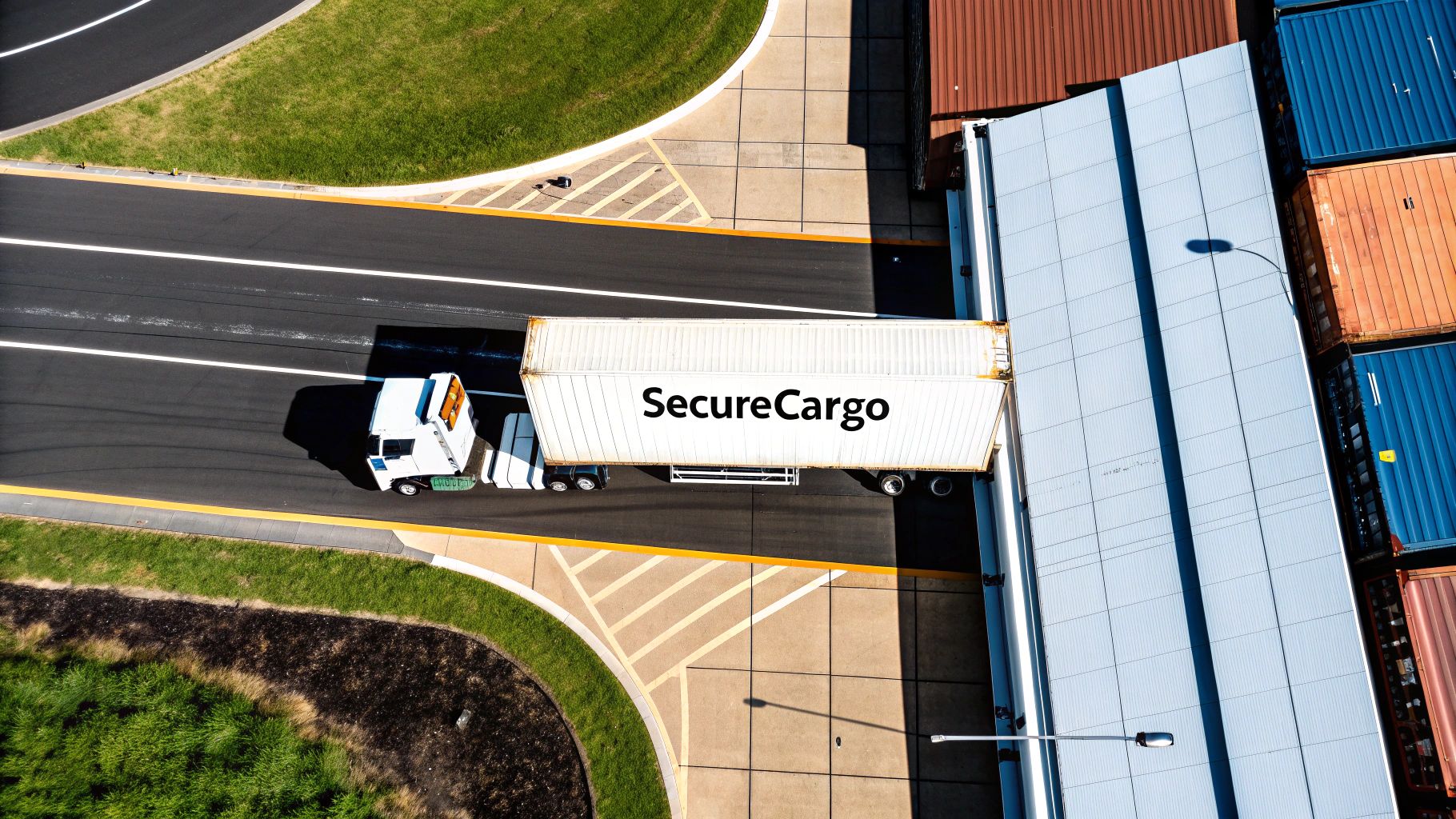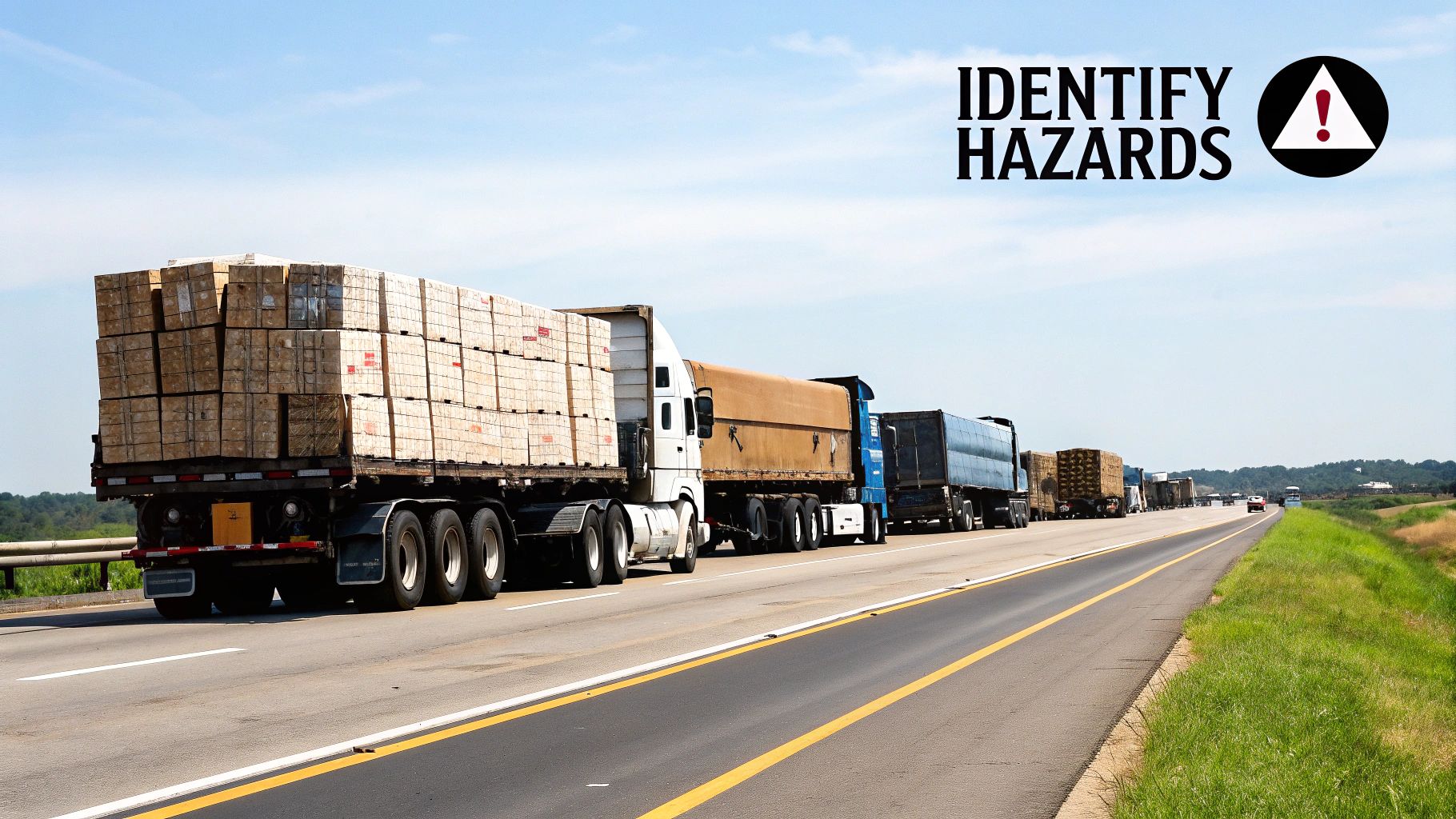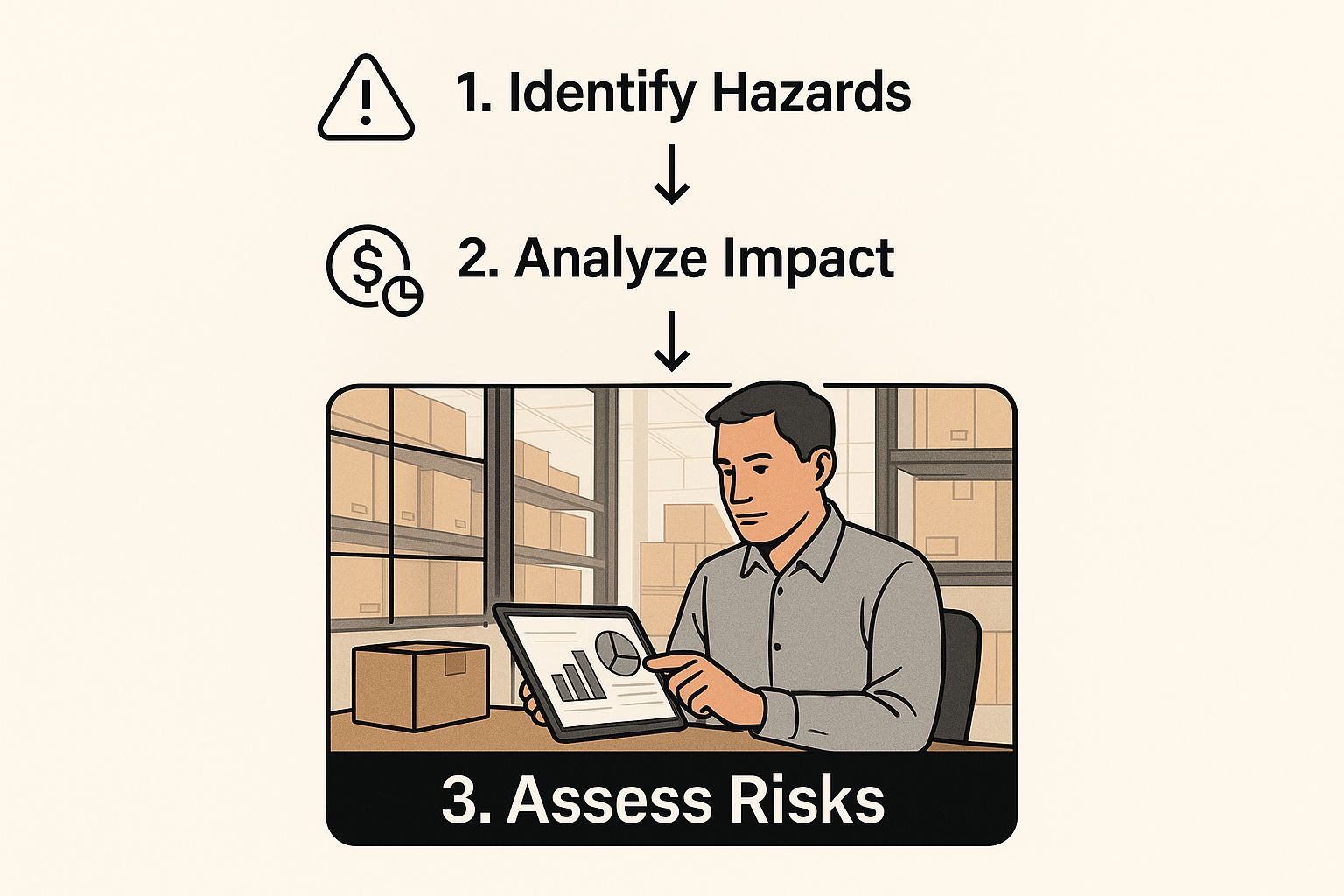Learn essential transportation risk management tips to safeguard shipments, lower supply chain risks, and ensure secure freight handling.

Think of transportation risk management as your shipment's personal bodyguard and GPS, all rolled into one. It’s the process of looking down the road, spotting potential trouble, and creating a game plan to make sure your freight gets where it’s going safely, on time, and in one piece.
This isn't about just reacting to problems. It’s about building a system so smart and resilient that most problems never even get the chance to happen.
Let's be honest—shipping freight without a solid risk plan is like sending it on a road trip with no map and a blindfold. You're just crossing your fingers and hoping for the best, praying it dodges everything from freak blizzards and highway accidents to cargo thieves. That’s not a strategy; it’s a gamble. And in logistics, the house always wins.
A good risk management plan flips the script. Instead of putting out fires all day, you're building a fire-proof supply chain. You start creating a system that’s predictable, reliable, and ultimately, far more profitable. It’s the quiet confidence that comes from being prepared.
At its heart, managing transportation risk is all about asking "what if" before you're forced to. What if a hurricane shuts down a major port? What if your carrier's truck breaks down in the middle of nowhere? What if your LTL shipment gets banged up at a chaotic cross-docking terminal?
When you have answers ready for these questions, a potential disaster becomes a minor hiccup. The real goal is to shield your business from the big three headaches:
This forward-thinking approach has never been more critical. Modern supply chains are a tangled web of global complexities. A recent survey of 400 senior transportation executives revealed that 68% view trade disputes as a major risk, and 62% cited geopolitical instability as a top concern. As you can see in the 2024-2025 Global Transportation and Logistics Risk Report, the world is a bumpy place, and smart planning is essential.
To get a handle on all this, it helps to break down the risks into a few key categories. Each one brings its own unique flavor of chaos and requires a different set of tools to manage.
Here’s a look at the most common types of transportation risks and how they can impact your business.
Common Transportation Risks and Their Business Impact
Getting familiar with these categories is the first real step. Once you know what you’re up against, you can start building a risk management plan that’s targeted, practical, and actually works.

Let's be honest, every shipment that leaves your dock—whether it's a full truckload or a single LTL pallet—is stepping onto a path filled with potential roadblocks. Smart transportation risk management isn't about being afraid of what could happen. It's about knowing exactly what you're up against so you can build a supply chain that bends instead of breaks.
Spotting these red flags early is the real secret. It’s what keeps a small hiccup from turning into a full-blown, costly catastrophe. To make it easier, we can break down the threats into three main buckets. Each one requires a different mindset and a unique game plan to keep your cargo, and your profits, safe.
Physical risks are the most obvious dangers to your freight. These are the real-world, hands-on events that can damage, delay, or destroy your cargo. Think of them as the hazards you can literally see on the road ahead.
You’re probably familiar with most of them:
Even a small mistake, like choosing a carrier with sloppy security habits, can paint a target on your shipment. Carefully vetting your partners and providing crystal-clear handling instructions is your best first move.
Next up are operational risks. These are the internal system failures—the cracks in your own process that can throw a shipment completely off course. A breakdown here can lead to frustrating delays and costs that just keep climbing.
An operational failure, like a simple documentation error, can be just as costly as a physical accident. It can trap a shipment in customs for weeks, leading to missed deadlines and storage fees that erode your profit margin completely.
These risks pop up from the actual mechanics of moving freight. Having a solid grasp of shipping fundamentals is key, and if you need a refresher, you can explore our complete guide on how to ship freight for a great starting point.
Here are the key operational risks to keep on your radar:
Finally, we have financial risks—the surprise hits to your budget that can turn a profitable shipment into a losing one. These dangers are often invisible until the final invoice lands on your desk.
Watch out for these common budget-busters:
Protecting your freight really starts with understanding where the dangers are hiding. When you can spot the signs of physical, operational, and financial risk, you can make smarter choices, find better partners, and build a shipping strategy you can actually count on.
Alright, so you've got a list of all the things that could go wrong with your freight. That's a great first step. But staring at a long list of "what-ifs" can feel pretty paralyzing, right? The truth is, effective transportation risk management isn't about trying to stamp out every single potential problem. It's about knowing where to point your energy and resources to get the most bang for your buck.
The real goal here is to transform that scattered list of worries into a focused, prioritized action plan. This means you need a structured way to look at each threat. Think of it like creating a weather forecast for your supply chain—you’re not just saying it might rain, you’re figuring out how likely it is and how badly it could mess up your day if it does.
A "risk assessment framework" might sound overly corporate or complicated, but I promise it's not. At its core, it just boils down to asking two simple questions for every risk on your list:
Answering these two questions is a game-changer. It helps you separate the minor headaches from the genuine catastrophes. This simple process gives you incredible clarity, making sure you don't waste time and money on a minor issue while a huge vulnerability is hiding in plain sight.
This is where digging into the data really pays off. You need to get comfortable with the numbers to see the full picture.

As you can see, analyzing performance metrics and historical data is central to figuring out which transportation risks need your immediate attention.
First things first, let's figure out the odds. For each risk, you need to estimate how likely it is to occur. This isn’t a wild guess; it’s an educated one based on real-world information and your own experience.
Here’s what you should be looking at:
Once you’ve considered these, give each risk a simple rating—low, medium, or high. This first pass helps you quickly filter out the truly far-fetched scenarios.
Next up, you have to play out the "what if." If a risk becomes a reality, what’s the damage? A slight delay is one thing; a stolen truckload is something else entirely.
Think about the impact across your whole business:
Just like before, assign a low, medium, or high rating. Don't forget, a risk with a low probability but a catastrophic impact is still one you need to take very seriously.
The goal is to understand the true cost of failure. A seemingly small operational risk, like frequent LTL shipment delays, might have a high cumulative financial impact over a year, making it a higher priority than a rare but dramatic event.
Now it's time to put it all together with a risk matrix. This simple grid is probably the most powerful tool in your assessment toolkit. It lets you visually map out every risk based on its likelihood and impact, showing you instantly where you need to focus.
Anything that lands in the High Likelihood / High Impact box is a red alert. These are your top priorities and need immediate action plans. On the flip side, risks in the Low Likelihood / Low Impact corner can just be monitored for now—no need to throw significant resources at them.
Getting this process down is more important than ever. The global transportation and logistics sector is expected to grow by 4.1% in the coming year, driven by both business investment and consumer spending. More growth means more freight, more complexity, and more potential pitfalls, making a solid risk management plan absolutely essential. If you want to dive deeper into these trends, you can check out the latest logistics statistics.

Alright, you've done the hard work of spotting and sizing up your biggest threats. Now it's time to get proactive and build your defenses. This is where effective transportation risk management really comes to life, shifting from assessment to action. We're talking about creating a smart, strategic playbook to protect your cargo, whether it’s a full truckload (FTL) or a less than truckload (LTL) shipment.
Think of it like building a fortress around your freight. You wouldn't rely on just one wall to protect a castle, right? You’d want multiple layers of defense. The same idea applies here. A truly resilient supply chain is built by weaving together several different tactics to keep your shipments secure. Let's dive into some of the most effective strategies you can start using today.
Relying on a single carrier for all your freight is a massive gamble. What happens if they have a sudden breakdown, face a labor strike, or run into financial trouble? Your entire supply chain can grind to a halt. It’s a classic single point of failure, and it can be absolutely catastrophic for your business.
Spreading your freight across a diverse group of carriers is one of the smartest moves you can make. By working with a mix of national giants, reliable regional players, and specialized carriers, you build incredible flexibility into your logistics. If one partner suddenly can't perform, you have other vetted, ready-to-go options. This strategy not only slashes your dependency but can also open up new avenues to reduce freight costs by comparing different rates and service levels.
Here’s a costly mistake I see all the time: confusing carrier liability with actual freight insurance. They are worlds apart. Carrier liability is just the bare-minimum, legally required coverage, and it's often based on weight. To even collect, you have to prove the carrier was negligent, and it rarely—if ever—covers the full value of your goods.
Relying on carrier liability alone is a major financial vulnerability. True freight insurance is your safety net. It's designed to protect the full declared value of your cargo against loss or damage, no matter who's at fault. It’s a non-negotiable part of any serious risk management plan.
Getting a separate, all-risk cargo insurance policy gives you genuine financial protection and, just as importantly, peace of mind. It turns a potential disaster into a manageable, covered event.
You can't manage what you can't see. It wasn't long ago that a shipment would vanish into a "black box" between pickup and delivery, leaving you to just hope for the best. Thankfully, today's technology gives us the visibility we need for proactive transportation risk management.
Using tools for real-time tracking is no longer a luxury; it’s essential. GPS devices and modern logistics platforms feed you minute-by-minute updates on your shipment's location and status. This visibility is a game-changer, allowing you to:
Visibility turns you from a passive worrier into an active manager, empowering you to make smart, on-the-fly decisions to protect your freight.
Even with the best-laid plans, things will go wrong. A port will close unexpectedly. A freak snowstorm will shut down a major highway. The real difference between a minor hiccup and a full-blown crisis is having a solid contingency plan ready to go.
This doesn't have to be a 100-page manual. Your plan should be a simple, clear guide that tells your team exactly what to do in common "what-if" scenarios.
Having these plans documented removes the panic and guesswork. It allows your team to respond with speed and confidence, keeping your supply chain flowing.
In logistics, flying blind just isn't an option anymore. Relying on gut feelings and putting out fires as they pop up simply can't keep pace with the modern supply chain. This is where technology comes in—not as another complicated tool, but as your sharpest partner for transportation risk management.
The right digital tools are completely changing how we protect freight. They provide a level of visibility and control that was pure science fiction just a decade ago. It's about moving risk management from a game of chance to a game of strategy.
If you're building a tech-first risk strategy, the Transportation Management System (TMS) is your foundation. Think of it as the central nervous system for your entire shipping operation. A good TMS pulls all your scattered logistics data—from carrier rates and routes to tracking updates—into one organized command center.
Without one, you're stuck digging through emails, spreadsheets, and phone logs, trying to piece together a puzzle. A TMS creates a single source of truth, giving you the clarity to make sharp, data-backed decisions. This centralization is what allows you to spot trends, control costs, and react to disruptions before they become disasters.
The numbers don't lie. The global TMS market was recently valued at around USD 11.0 billion and is on track to hit USD 44.5 billion, growing at an incredible 15% CAGR. With North America leading adoption and the manufacturing sector as the biggest user, it’s proof that a TMS is no longer a luxury—it’s essential. You can dive deeper into how these systems are shaping modern supply chains.
Beyond a central system, the real magic happens out on the road. Today's technology gives you eyes and ears on your freight every step of its journey. This real-time visibility is a total game-changer for tackling physical and operational risks head-on.
A few key technologies work in concert to make this happen:
These technologies aren't just for mega-corporations anymore. They've become much more affordable and accessible, making them a must-have for any business looking to build a more resilient and predictable supply chain.
By embracing these tools, you flip the script on risk. Instead of waiting for a frantic call about a problem, you get an alert that an issue might be developing. That gives you time to think and act. This proactive approach is what modern, effective transportation risk management is all about.
Good transportation risk management is more than just putting out fires as they pop up. It’s a complete shift in mindset—moving away from reacting to problems and toward proactively building a supply chain so tough it can handle whatever the world throws at it. You’re not just trying to survive today; you're building an operation that's ready for tomorrow.
This forward-thinking approach really comes down to three core pillars. When you get these working in sync, your logistics network transforms from a constant source of stress into a real competitive edge. You'll stop hoping for the best with your shipments and start taking control.
A truly resilient operation doesn't happen by accident. You have to build it intentionally by focusing on creating a nimble and transparent network.
It's so important to remember that risk management isn't a one-and-done project you can just check off a list. It’s a living, breathing cycle of continuous improvement. The world changes, new risks pop up, and your business grows—your strategy has to keep up.
A resilient supply chain is a learning supply chain. Every single delay, every damaged pallet, and every near-miss is a valuable piece of data. Treat these events like lessons to sharpen your processes, update your contingency plans, and make your operation that much smarter for the next shipment.
This kind of thinking turns every challenge into a chance to get better. By constantly assessing, mitigating, and learning, you create a system that genuinely gets stronger over time.
You can't build a resilient supply chain all on your own. The logistics partners you bring on board are a direct extension of your business and a reflection of your commitment to your customers. That's why it's critical to work with carriers and brokers who make security and transparency a top priority.
Look for partners with proven track records and solid systems in place to protect your freight. This is especially true when dealing with the unique challenges of consolidated cargo; you can learn more about handling LTL freight loads to better understand these specific risks.
Ultimately, putting these strategies into practice gives you the power to take control. You can finally stop worrying about all the "what-ifs" and start building a reliable, predictable, and profitable logistics operation that’s ready for the future.
Let's be honest, figuring out transportation risk management can feel like trying to solve a complex puzzle. You've got questions, and you need clear, straightforward answers to build a plan that actually works. Let’s tackle some of the most common ones we hear from shippers.
Getting your strategy off the ground might seem like a huge task, but that first step is everything. It's the foundation for a secure and resilient supply chain.
It all starts with a thorough risk assessment. You can't protect against threats you don't see coming. So, the very first thing to do is map out your entire supply chain, from start to finish, for both your FTL and LTL shipments.
Once you have that map, start brainstorming everything that could possibly go wrong. Think about the obvious stuff like theft and damage, but also dig deeper into operational hiccups like carrier delays or surprise accessorial fees that blow up your budget. For each risk you identify, figure out how likely it is to happen and how bad the damage would be. This simple exercise immediately shows you where to focus your time and money.
Great question. While the goal is the same—safe delivery—the specific dangers you face are quite different. With a Full Truckload (FTL) shipment, all your eggs are in one basket. Your risks are concentrated. If that one truck has an accident, gets delayed, or is targeted for theft, your entire shipment is compromised. So, for FTL, the game is all about meticulous carrier vetting, planning the smartest routes, and securing that single end-to-end journey.
Less Than Truckload (LTL) is a completely different ballgame. Your freight is on a truck with shipments from lots of other companies, which introduces a whole new set of variables. The biggest worries with LTL are damage from being handled so many times at different terminals, cross-contamination from other cargo, and delays that pop up during the consolidation process. To win at LTL risk management, you have to be obsessed with tough packaging, perfectly clear labeling, and picking carriers who have their hub-and-spoke system running like a well-oiled machine.
Yes, 100%. This is a point that trips up so many shippers, and it's a costly mistake to make. Carrier liability is not insurance. Not even close. Carrier liability is a legal requirement that's incredibly limited—it often only covers pennies on the dollar based on weight, not the actual value of your goods. Worse yet, you have to prove the carrier was negligent to collect anything at all, which is a tough, uphill battle.
Freight insurance, on the other hand, is your safety net. It’s designed to protect the full value of your goods from loss or damage, no matter who's at fault. Relying on carrier liability is like gambling with your bottom line. A real insurance policy buys you genuine peace of mind and solid financial protection.
Technology is a game-changer here. It gives you a level of insight and control that was just a dream a decade ago, letting you move from just reacting to problems to actively preventing them.
These tools are your eyes and ears on the ground, empowering you to spot trouble and fix it long before it becomes a catastrophe.